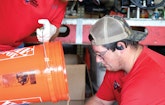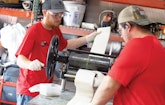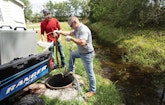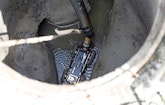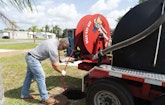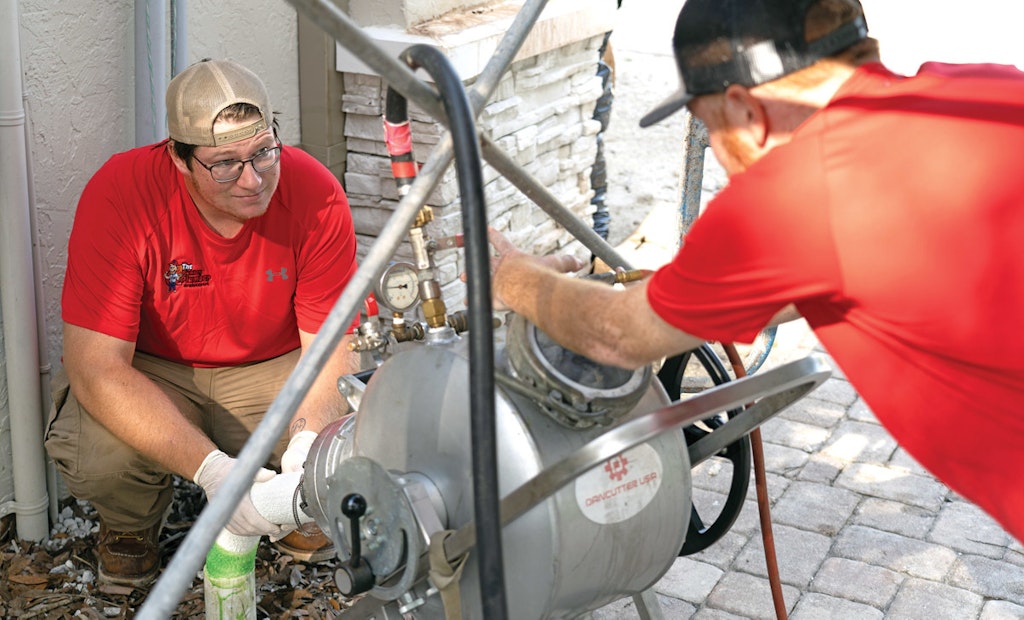
Head lining technicians Jonah Yerian and Cayden Pegg monitor the inversion machine as they install a liner on a pipeline rehabilitation job.
Interested in Inspection?
Get Inspection articles, news and videos right in your inbox! Sign up now.
Inspection + Get AlertsWhen Rick Hedge, the owner of The Plumber’s Plumber in Fort Myers, Florida, graduated from college with a degree in real estate and finance, he wasn’t sure where his career was headed.
But his father, Dick Hedge — a drain cleaner and plumber — gave him a unique graduation gift that left no doubt what he thought his son should do: a PipeHunter Lil Boss drain cleaning machine.
“I didn’t know what I wanted to do,” he recalls. “But I know I didn’t want to answer to other people. My dad always told me that working for yourself allows you to create your own destiny. I didn’t know what that meant back then, but I sure do now.”
So Hedge, who already had worked for his father for years, accepted the challenge and opted to give drain cleaning a shot. But his father, who owned a company called Econo-Rooter in Fort Myers, Florida, didn’t have enough work at the time to keep both of them busy.
So Hedge had to figure out how to build a customer base on his own. Despite his experience, it was no cakewalk.
“It was hard at first,” he says. “But I knew that if this was where my life was going, I needed to figure it out. So I made up flyers and started to grab something for myself.”
His will to succeed and strong work ethic served Hedge well. He eventually steered the company into trenchless pipeline repair a little more than 20 years ago, sensing that pipe bursting and pipe lining — technologies that were in their infancy back then — were the future of the industry.
His instincts were correct. Today the company, now called The Plumber’s Plumber, is one of the leading trenchless pipeline rehab companies in southern Florida. And Hedge no longer worries about finding new customers.
Influential mentor
Hedge says his father has been instrumental to both the company’s success and Hedge’s professional development.
“He’s been the biggest influence in my life and he’s the best guy ever,” Hedge says of his father, who handed over control of the company to his son in 2018 but still comes to work every day. “He’s an upstanding, respectable guy — old-school tough. And he did pretty well in creating a rock-solid foundation for the business.”
The company’s roots date back to 1980, when Dick Hedge bought a company called Econo-Rooter for $4,000. He still holds the plumbing license for the company, which has changed names a couple times over the years, and mostly coaches and trains young employees.
At the start, the business focused mostly on drain cleaning and minor plumbing repairs. But in 2001, they changed the name of the business to Trenchless Solutions to better reflect its new direction: pipe bursting with a TRIC Tools system.
But at the time, few people knew about trenchless technology. So in 2008, the company name changed again, this time to The Plumber’s Plumber.
“I was brainstorming names with a group of guys who had plumbing businesses,” Hedge says. “And one of them said, ‘You work with other plumbers and do the jobs they don’t want to do. You’re the plumber’s plumber.’ And the name stuck.
“We’re not saying we’re better than other plumbers; we just do things differently.”
New strategies
Two strategies primarily spurred the company’s growth: price increases and an emphasis on continually reinvesting in new technology. And his father’s experiences played a role in formulating those strategies.
For years, Hedge had watched his father clean residential drainlines, then repeatedly return for profit-eroding free callbacks when the drains continued to clog.
“It wasn’t his fault the backups continued,” Hedge explains. “It’s just that the pipes were bad. But his mindset was to always take care of customers and make them happy. He never cared much about money.
“But I was more aggressive and motivated. I have four kids and a wife that want nice things. That motivated me, but he didn’t need all that.”
To stop the callbacks, Hedge made an important investment in equipment: a RIDGID SeeSnake inspection camera.
“That camera changed our business,” he says. “From then on, we could show customers what the problem was and tell them the pipes would keep on clogging unless they were fixed. It put us in a completely different frame of mind and things took off after that.”
Hedge also pushed to raise prices, something his father was reluctant to do.
“We started pushing up prices hard and charging what the market would bear,” he says. “I learned from mentors that if about 30% or less of your customers don’t complain about your prices, then you’re not charging enough.”
Hedge’s father warned him that the company might lose some business by raising prices. And he was right, Hedge says.
“But we lost the bad customers and gained better customers. And we had more money to buy better tools, drain machines and cameras, as well as attract customers that were less concerned with prices and more concerned with quality workmanship.”
Today, about 60% of the company’s revenue comes from trenchless drainline repairs, typically 2- to 4-inch-diameter cast iron pipes buried in slabs under homes. Drain cleaning contributes another 25% and the rest is generated by minor plumbing repairs and fixing waterline breaks, Hedge says.
“The drain cleaning is critical because it leads to trenchless repair jobs.”
Equipment fuels growth
The company’s roster of equipment reflects the Hedge’s philosophy of continually reinvesting in revenue-enhancing equipment. For drain cleaning, the company relies on PipeHunter Lil Boss and Big Boss trailer-mounted water jetters (24 gpm at 4,000 psi and 35 gpm at 3,000 psi, respectively); a Brute propane-powered jetter from Jetters Northwest (9 gpm at 4,000 psi); a RIDGID drain machine; an Electric Eel cable machine; a RotoMidi milling machine from Boldan Pipe Technologies; Mini and Maxi Millers from Picote Solutions; and a milling machine built by Renssi Finland Oy.
The company also relies on a variety of inspection cameras, including push cameras from Forbest Products, Rothenberger Werkzeuge GmbH, RIDGID and CamTronics (a brand distributed by EPL Solutions); and a ROVVER X crawler camera system carried on a Polaris Ranger all-terrain vehicle. It also owns a Superior smoke detection machine from Superior Signal.
The company also owns a MidiCoater pipe coating system from Spraypoxy Oy in Sweden. In addition, it has invested in pipe lining equipment made by Renssi and Sacpro and uses T-liners from Repiper AB in Sweden and felt Brawoliner liners from Brawo Systems GmbH.
“We mix and match the best technologies from all over the world,” Hedge explains. “I got beat up real bad when we first started lining pipes, but I kept getting back up, and found the best products in the world and put them all together to create our own systems.
“I’m a reflection of what I learned at places like Picote, Sacpro, Boldan and Renssi. They taught me what I preach every day. They’re all awesome, top-notch, amazing companies.”
Hedge firmly believes that requiring certification for companies that do pipe lining would be good for the industry. For starters, it would ensure a certain standard of quality workmanship for customers. And on a larger level, it would be good for the industry because it would eliminate contractors that do poor work, he says.
“Some places want to outlaw pipe lining because of liner failures,” he says. “I’m not big on more regulation. But we have to make sure consumers get quality workmanship so it doesn’t hurt the overall pipe lining industry.
“Pipe lining is great technology — when it’s done right,” he adds. “But not enough guys do it right and customers don’t realize if they’re getting bad work or quality work.”
Hedge also advocates for a higher level of training and education for pipe liners to create quality tradesmen for the industry.
Embracing overseas technology
Hedge praises the technology coming from Europe, where pipes are even older than in the United States and installation standards are more rigorous. For example, independent inspectors must examine lining work to ensure it meets certain standards before contractors get paid.
As such, there’s less emphasis on speed and profitability and more emphasis on workmanship and quality, Hedge says.
“I’ve built our reputation on being different from everyone else. We strive to achieve European standards. In our early years, we aimed for speed. But now we work toward thoroughness, cleanliness, perfection, quality and longevity, with money as the lowest priority. And we still make a good living. We’re really good at what we do and I’m very proud of that.”
One key to the company’s success is its tight-knit crew, led by Cayden Pegg.
“I’ve taught him everything I know,” Hedge says. “He’s been very receptive and has embraced this industry and technology. He’s my No. 1 man and he’s only 25 years old.”
Rounding out the crew are Pegg’s right-hand man, Jonah Yerian; Jerry Swanson; Pegg’s cousins, Joey Retherford and Corey Parzyck; lead plumber Josh Ricks; and Hedge’s wife, April.
“We’ve got a pretty good little team and I’m real proud of them,” Hedge says. “They make it fun because they want to learn and they realize how good this industry is and how much potential it has — and how much potential they have.
“Basically, the sky is the limit for their future in this industry.”
Slow-growth mode
Looking ahead, Hedge eventually would like to slow down and have someone else manage the business. But in the meantime, he’s not keen on rapid growth that could diminish quality control and decrease customer satisfaction.
“We not trying to grow,” he says. “In fact, it’s easier not to because finding good employees is so difficult. We do very well with what we have. You’re not going to see 20 or 30 guys in this company. I want a small group of guys who are awesome workers and employees, and that’s exactly what we have right now.
“So we’ll keep paying them well, treating them well and giving them what they need in terms of tools and equipment. If you take good care of employees, they’ll take good care of you.”

